Mexico’s Walls Exclaim: “The Revolution of the 21st Century will Arise in Oaxaca”
 Canek - visualresistance.org Canek - visualresistance.org


| | The pictures in this post were taken by Sasha Hammad. Thank you to her. | 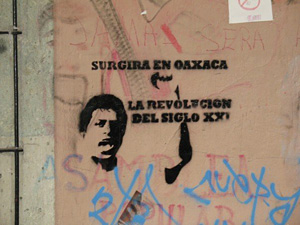
| | | 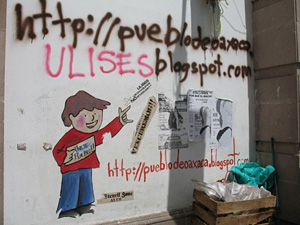
| | | 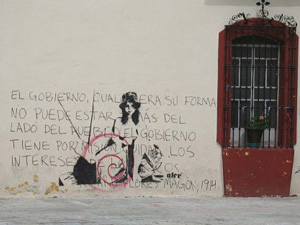
| | | 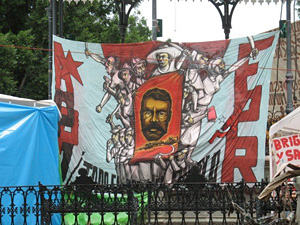
| | | 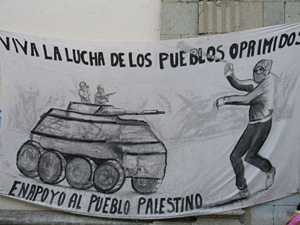
| | | 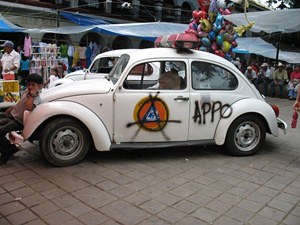
| | |
For decades, teachers in Oaxaca, Mexico, have conducted strikes to demand educational reform from the federal and state government. Some of the teacher’s demands include living wages, sanitary schools, text books, and more public school facilities. Historically, these strikes have lasted short periods of time and caused minimal or no disruption to the state’s economy. The government, except for minor concessions, has been able to ignore the teacher’s strikes and their demands.

An independent journalist, referred to by the Mexico Solidarity Network as an “unidentified Chicano,” reports:

May 15, 2006: It’s National Teachers Day in Oaxaca. And the leadership of Oaxaca’s 70,000 teachers representing Section 22 of the National Teachers Union declared that if there was no further movement in their negotiations with the government, then the following week “would see a state-wide strike by Oaxaca’s school teachers” and that “This one will be different than all the previous strikes”...

May 22-24, 2006: 70,000 Oaxaqueño school teachers go on strike. And the first indications that this was to be a “different” kind of strike were immediately apparent in and around the city’s historic centre. There, for the first time, the teachers, in the thousands, erected a tent and awning city, occupied day and night in the Zocalo and in the streets surrounding the Zocalo. It’s a peaceful occupation of the city’s center, but it is also immediately apparent that more teachers are coming into the occupied area on a daily basis. And these teachers are not just from the City of Oaxaca. They’re swarming in from the outlying villages and towns in the Valley... (Mexico Solidarity Network Weekly News and Analysis, August 21-27, 2006)

The teacher’s strike, their encampments, their independent media infrastructure, and their continuous mass mobilizations (marches reaching up to 300,000 people) have been perceived as a serious threat to Mexico’s dominant political and economic order. In the early morning of June 14, 2006, the state attempted to crush the teacher’s movement by launching an army of several thousand uniformed and plain clothed state and municipal police in an all out attack against the teachers. Police violently destroyed the encampments and scattered the teachers throughout the city.

Within two days, the teachers released the names and photos of 12 teachers and 3 students who were killed and/or disappeared during the attack. The government denies the charges. To date, it is confirmed that five union members have been shot and killed by police.

Since the June 14th attack, teachers and their sympathizers have taken the city center back. They have rebuilt their encampments, their radio stations, their newsletter circulation, and their barricades. The mass mobilizations continue and, following a police attack on independent radio stations, they have been complimented by another effective tactic, the occupation of main stream media centers. From here, the teachers have promoted their most recent and immediate demand, the resignation of Oaxaca Governor Ulises Ruiz Ortiz.

Government repression also persists. Police continue to attack and kill members of the APPO, a recently formed network of organizations sympathetic to the teachers strike and dedicated to removing Governor Ortiz from power. On August 22, 2006, police attacked APPO members who were guarding commercial station La Ley 710, killing Lorenzo San Pablo Cervantes, head of the education sector of the state Department of Public Works and an APPO sympathizer.

For more information check out these websites:

• narconews.com (English)
• Mexico Solidarity Network News and Analysis (English)
• Indymedia, Mexico (Español)
• Indymedia Mexico, Desalojo Oaxaca (Español)
• Centro de Medios Libres, DF (Español)
• Indymedia, Chiapas (Español)

Granito de Arena: Award-winning Seattle filmmaker, Jill Freidberg (This is What Democracy Looks Like, 2000), spent two years in southern Mexico documenting the efforts of over 100,000 teachers, parents, and students fighting to defend the country’s public education system from the devastating impacts of economic globalization. Freidberg combines footage of strikes and direct actions with 25 years worth of never-before-seen archival images to deliver a compelling and unsettling story of resistance, repression, commitment, and solidarity. |



